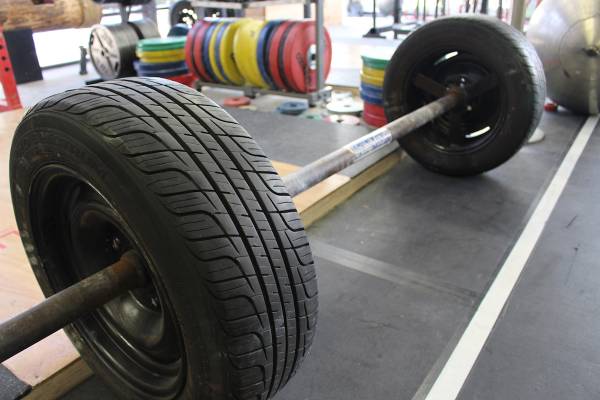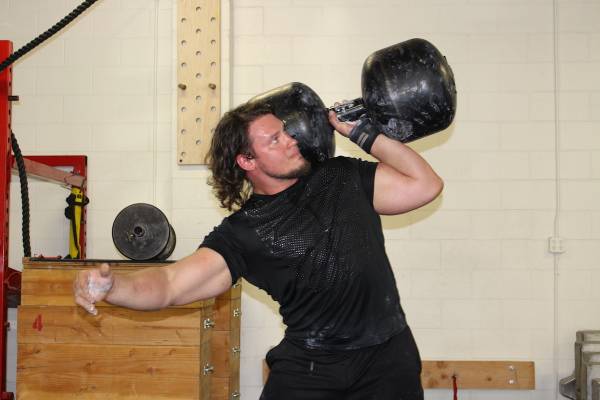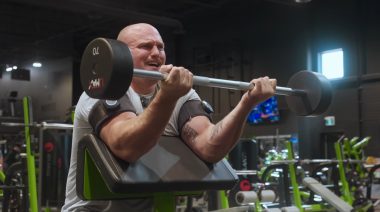Barbells, kettlebells, and dumbbells everyone gets. They are the tools of strength and conditioning. Strongman has them, too. They are called logs, axle bars and circus bells.
Strongman is a pure form of strength training that is solely about picking up really, really heavy stuff and moving it. Strongman workouts are also be about to change your approach to training, as the sport grows in popularity.
Much like Olympic weightlifting, CrossFit coaches are embracing strongman movements as part of their coaching curriculum. Strongman is coming to a gym near you, and you should be excited about that. It may look intimidating, but according to two CrossFit coaches who have been using it for some time, you might be surprised at how easy it is to integrate it into your existing workouts.
Strongman Meets CrossFit
We sat down with Michael Tromello of Precision CrossFit and Vaughn Brotton of Axiom CrossFit recently to talk about strongman, CrossFit, and getting freakishly strong and fit.
“If you look at the Crossfit Games the last couple of years,” says Tromello, “they had a really heavy kettlebell with squats—that’s a farmer’s carry. They did D-balls with the Masters, 150 pound D-balls, ground over shoulder. They did axle bar hang cleans and jerks in the finals.”
In fact, the axle bar was first introduced at the CrossFit Games in 2012. So, strongman has been there all along but we may not have thought of it that way. Like most things in CrossFit competitions, there was a lot of what you should be doing, and not a lot of how and why.
“I was sitting at the Crossfit Games with masters athlete James Grundler trying to get him ready for the finals, and I’m teaching him how to do an axle bar continental clean. Every single masters is staring at us trying to figure out what the hell we’re doing.”
What Makes Strongman Different?
How does strongman compare to weightlifting or powerlifting? The obvious difference is the equipment. The barbell is at the center of both weightlifting and powerlifting. Strongman, while it may have some bar work, treats a variety of objects as weights: stones, yokes, even trucks and airplanes. These objects and many others may be pushed, pulled, carried, tossed, or a combination of each.
Strongman competitions don’t use bumper plates; they use cars
In addition to his CrossFit gym, Brotton also runs strongman clinics around the country for other gyms. “I came from the Marine Corps,” he says, “so everything was ‘keep it simple, stupid.’ When you go over to help someone move their house, does everything turn into a barbell? No. If you don’t know how to pick up things and move them in a functional manner, you’re going to get hurt. There’s a lot of benefit to learning these lifts and learning how to do them correctly, because when the odd object does come up, you know how to pick it up and move it.”
Brotton continues, “I gave an example once: my friend moved and he had a 350 pound planter with a palm tree in it, so he just rolled it off to the side and he said, oh, it’s a stone. He picked it up and lapped it and set it in the back of his truck, just like we would do stones in strongman. He said, I would have never have done that if I didn’t look at it that way.”
If you are familiar with strongman from watching World’s Strongest Man competitions, you might be forgiven for not knowing how this relates to you, but established CrossFit pros like Tromello and Brotton see it as being part of the evolution of CrossFit training.
“I’m not going to take someone off the street, and have them pick up a 600lb stone,” says Brotton. “That’s just not going to happen. Over time, they would obviously get stronger. The benefit is they’ll notice the small things like, hey, I’m holding onto the pull up bar a little bit more and a little bit longer because of all of the grip strength work we’ve been doing. Or, hey, my deadlift’s jumped 25 pounds, and I haven’t even touched a barbell. Why is that happening? Because you’re doing farmer’s walks every week. You’re really working that back and legs.”
For Tromello, strongman goes back to the core of Crossfit’s ethos that you have to be good at everything, but master at nothing. The idea of the theoretical fittest person, whether it’s in the gym, your back yard, or at the Crossfit Games, is that they are good at everything that is fitness.
“Last I checked, strongman was as much a part of fitness as pilates,” says Tromello. “If you want to call yourself a great CrossFitter, you better be able to do a triathlon, and you better be able to pick up a heavy stone. That’s CrossFit.”
He continues, “I look at a lot of the top CrossFit coaches, and they’re doing strongman elements. They’re doing rope pulls with a sled. They’re doing lapping. They’re doing stone carries.”
For the average person, beyond fitness and strength, there is the element of fun. Strongman is a breath of fresh air if all you have had to deal with it is barbells, dumbbells and kettlebells for years.
Brotton also believes that there is a direct connection between strongman and CrossFit performance which is helping create a groundswell of enthusiasm for strongman proper. He gives the example of one of the standard WODs, “You’ve done Grace; you probably have a two-minute Grace, and that’s awesome. Now do a sandbag Grace, and see how horrible that is. It’s not going to be done in two minutes.”
Starting Strongman
You ready to get into it, now that you know the practicalities? Where do you begin with strongman workouts? What are the exercises that you should focus on as you start your strongman adventure? Obviously, they have be doable and practical in your gym. At Tromello’s facility in Agoura Hills, California, the strongman equipment looks like it is homemade: hunks of metal welded together, and stones, and heavy bags. It’s not the pretty, chrome stuff you might be used to.
15 minutes up the road from Precision CrossFit is The Training Hall, in Newbury Park, California. The Training Hall is a pure strongman facility, founded by Odd Haugen, a 68-year old legend in the strongman community. Walking in for the first time, you might be forgiven for thinking that the starting weights are more than the ending weights at most normal gyms. The Training Hall is unique. It breeds champion strongmen like Martins Licis and Jacob Finerty.

The Training Hall, a strongman gym in California
For CrossFit coaches like Tromello and Brotton, strongman training doesn’t lead to strongman competition. It’s still all about the CrossFit Open, Regionals, and Games.
Tromello, who trains teams and athletes for success at many CrossFit competitions, the way to get people into strongman is to see it as a supplemental routine: “I look at strongman as a way of making the CrossFit athlete stronger at CrossFit. I see it as a tool to make them better at CrossFit. I love working with the sled, getting them to pull the rope, hand-over-hand as fast as they can, which means they’re improving their legless rope climb, because their arms are now going to be stronger. When I see them doing axle bar work, I’m now using another different element to get them better at their barbell work. If they can cycle an axle bar, they can cycle a barbell.”
And if you do axle bar work, you may end up begging to go back to barbell work. It’s a different kind of hard that can help re-energize your traditional training.
“You can do 30 clean and jerks with the sandbag for time,” Tromello continues. “You’ll be so good at doing 30 clean and jerks, the barbell cycling is going to pick up. Another thing that strongman does is it takes away your oxygen. You have a stronger chest. It puts you in very uncomfortable positions. If you can be really uncomfortable with stones on your chest and awkward movements, then when you get into CrossFit work and you have a little bar on your chest you’re going to breathe a lot better.”
The combination of unpredictability, the stresses of the lifts and walks, and the sheer exertion required, makes strongman almost an ideal supplemental training for CrossFit competitors. CrossFit owes a lot to strongman, because the actual competition events don’t look that far apart in terms of functionality.
The appeal of strongman to the layman is there, and it should grow as more gyms expose their membership to it. There is something inherently more practical about picking up strongman objects than learning the Olympic lifts. Sometimes a good snatch seems like it requires a maths degree to complete. The techniques of strongman lifting are very uncomplicated and, at the end of the day, it makes your other, more traditional, lifts that much better.

Strongman Martins Licis lifting a 200 pound circus bell at The Training Hall in California
Brotton is adamant about strongman work translating into traditional lifting, “It’s about having everything working correctly. The benefits are just astronomical. I mean, take one simple thing of strongman, the yoke walk: if you have somebody yoke walking once a week at different distances with different weights, they’re going to be stronger. Their deadlift is going to get stronger. Their clean pull is going to get stronger. Their snatch pull is going to get stronger. They’ll have less rounding when they go to their maxes, and they’ll just be a better overall athlete. Like Mike said, that bag sitting on your chest, oh my god, you’ll pray to get that thing off of you.
“It’s a tangent, but I use swimming in the exact same aspect. If you can swim a thousand meters for time, and that goes up, then you’re going to run faster. It’s a lot easier to breathe and run than it is to breathe and swim.”
Tromello agrees. “I say this all the time, the biggest problem I see with CrossFit programming, and when I look at CrossFit programs across the board, is everyone spends a ton of time focusing on getting better at the movement by doing the movement. No one spends any time actually making themselves stronger at the muscle groupings that require you to do the movement. So that’s what strongman is about. Supplemental work with strongman is going to make you better at doing the movement that you’re trying to do. I have a problem with toes to bar. I can’t hold onto the bar. Well if I do a bunch of farmer’s carries and I do that once or twice a week, my grip now gets better and I can do more toes to bar.”
The Ubiquitous Strongman
In the early days of CrossFit, if you had a gym, you’d be looking at $500 barbells, and a lot of people were building their own pull up bars using plumbing gear. Now, with popularity, the market has changed. You can get a replacement bar for about $100. You don’t worry about cracked bumper plates as much.
Strongman is more like those early CrossFit days. At Axiom, Brotton says most of the strongman equipment he built himself. “You look at my strongman area, it looks like someone went in there with a welder and just went to town,”
The early days of bodybuilding saw adherents working with self-made benches and equipment, too. That’s as good a sign as any that a more general form of strongman training is on the way; one that is adaptable to the average fitness enthusiast as well.
Strongman was a fringe strength sport, but it looks set to become mainstream. If you want to get into it, start your research now. It’s not going to be easy to find strongman training that you can trust. Remember, you are probably one of the early adopters. However, it’s also something that you can almost train for anywhere. Find something really heavy, pick it up, and move it. Rinse. Repeat.
Looking to start strongman training?






